
Do you know what a Collector’s ID card is? This post will tell you everything you need to know about this valuable but often overlooked, research tool. If you’re not already using them to more easily and enjoyably search for your ancestors in archives, museums, libraries, and other repositories of information, it’s time to start.
What Are Collector’s ID Cards?
Collector’s ID cards are a quick, reliable, and easy way to find information in archives, libraries, and other repositories of information. They’re helpful because they’re small, simple to use, and make it easier for researchers to get the most out of their research.
How Do They Work?
Collector’s ID cards are typically free, but some institutions in the United States charge a small fee. They look like business cards and give you access to information about a person or family.
These cards include the person’s name, date, and place of birth, date, and place of death, occupation, religion, cause of death (if applicable), spouse (if applicable), children (if applicable), and parents (if applicable). In some cases, the card also includes a photograph.
Why Should You Use Them In Your Research?
The dowódosobistykolekcjonerski (collector’s ID card) is a valuable resource for genealogical research, but they are often overlooked. They provide a way to search for collections of records that are not available online or through other methods.
Additionally, they can provide you with access to items that may be difficult or impossible to visit in person due to geographic constraints. This post will show you how to navigate the process of searching for and using a Collector’s ID card, so you can start using them in your research today.
Collector’s ID cards are a simple and effective way to manage your research. They provide a more accurate description of the item you’re looking for and will help you quickly find what you need in the archives or library you’re visiting.
It can be much easier to locate an item when it has a name, date, and location as opposed to just a number. For example, if you were looking for John Smith who lived in Missouri in 1864, it would be much easier to find him if he had an ID card with his name on it than if he only had a number assigned to him.
What Can They Tell You About Your Ancestor And Their Life?
Collector’s ID cards can give you a wealth of information about your ancestor. For example, the card may indicate:
– The person’s name and birth year
– Their occupation
– The place they were born
– The names of their parents (although not always)
– Where they died and when
– Any other interesting facts about them or their life that are noted on the card
Conclusion
Collector’s ID cards are a great resource for family historians. They are a convenient, inexpensive, and easy way to research your ancestors. They can tell you a lot about your ancestor, their life, and the time in which they lived.
Some of the information you might find on a Collector’s ID card is the date of birth, date of death, elementary school attended, the names of their parents, and the names of their grandparents. The information can help you find out where your ancestor was living and even what their occupation was.




